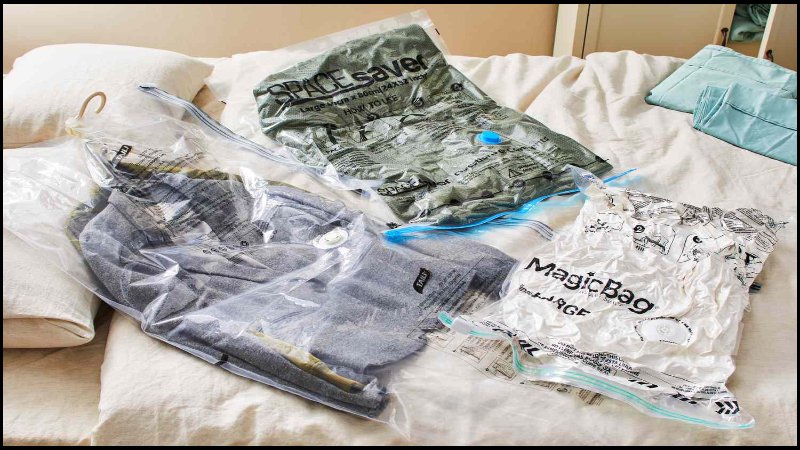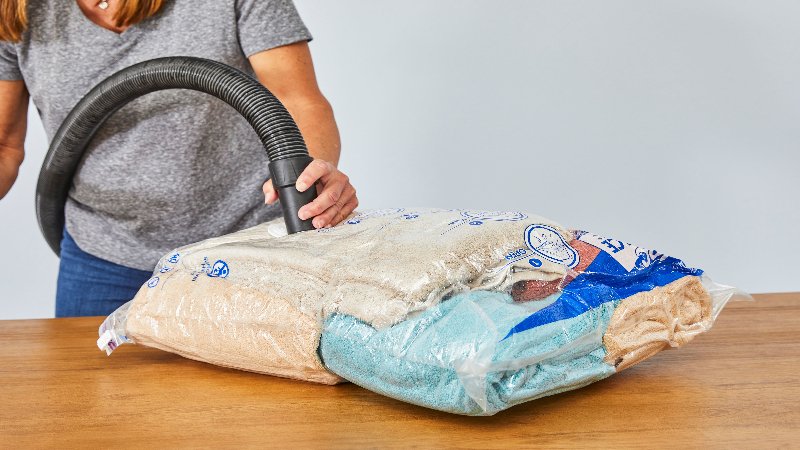Vacuum Zipper Bags: Maximize Storage, Protect Your Items
If you’re running a clothing business or simply seeking ways to improve your home organization, you’ve likely encountered challenges with storage. For clothing businesses, inventory damage from pests or moisture, and bulky storage that eats up valuable space, can directly impact profits and customer satisfaction.
At home, wasted food due to spoilage or freezer burn, alongside cluttered closets, are common frustrations. This comprehensive guide introduces vacuum zipper bags as a versatile solution, demonstrating the benefits for both food and clothing storage. The article will cover how to use them effectively and how to choose the right ones for specific needs. Let’s see!
1. What are Vacuum Zipper Bags?
Vacuum zipper bags are reusable storage bags designed with an airtight zipper closure and a special valve. This valve allows for the removal of air using a vacuum, creating a compressed, protected environment for the contents.
Unlike regular zipper bags, vacuum zipper bags provide a truly airtight seal, preventing air and moisture from re-entering after the vacuum process. This is the key difference that leads to superior preservation. They also differ from traditional vacuum seal bags, which often require a heat-sealing machine and are typically not reusable. Vacuum zipper bags, on the other hand, offer the convenience of a zipper for repeated use.
There are primarily two types of vacuum zipper bags, differentiated by their vacuuming method. Some are designed for use with handheld vacuum pumps, while others are compatible with clamp-style vacuum sealer machines. Choosing the right type depends on the vacuum sealer that is owned or planned for use.

2. Benefits of Using Vacuum Zipper Bags
Vacuum zipper bags offer a range of advantages, whether the priority is preserving food or protecting clothing.
2.1 For Food Storage
- Extending Shelf Life: Vacuum-sealing significantly slows down spoilage. Items like meat, vegetables, and leftovers can remain fresh for much longer when air is removed, inhibiting the growth of bacteria and mold.
- Preventing Freezer Burn: By removing air, vacuum zipper bags create a barrier against the harsh, dry environment of the freezer. This helps maintain the food’s original quality, texture, and taste, preventing the formation of ice crystals.
- Preserving Flavor and Nutrients: The airtight seal locks in the natural flavors and essential nutrients of food, preventing oxidation and degradation.
- Enhancing Marination: Vacuum sealing opens the pores of food, allowing marinades to penetrate more deeply and quickly. This results in more flavorful and tender results.
- Ideal for Sous Vide: Vacuum zipper bags are perfectly suited for sous vide cooking (a method of cooking food in a water bath at a precisely controlled temperature). The airtight seal ensures even cooking and prevents the bag from floating.
2.2 For Clothing Storage
- Comprehensive Protection: Vacuum zipper bags act as a shield against dust, moisture, and pests, all of which can damage clothing inventory.
- Significant Compression: Bulky items like sweaters, jackets, and winter wear can be compressed down to a fraction of their original size. This frees up significant storage space, a major benefit for businesses.
- Wrinkle Reduction: The compressed, protected environment helps to minimize wrinkles, making these bags ideal for both shipping and long-term storage.
- Seasonal Storage Solution: Vacuum zipper bags are perfect for organizing and storing off-season clothing, keeping items protected and compact until needed.
2.3 General Benefits
- Reusable and Cost-Effective: Unlike single-use bags, vacuum zipper bags can be washed and reused multiple times, offering long-term savings.
- Easy to Use: The process is simple: fill the bag, seal the zipper, and use a compatible vacuum pump or machine to remove the air.
- Space-Saving Design: By compressing the contents, these bags drastically reduce the amount of storage space required, maximizing efficiency in closets, warehouses, or shipping containers.
- Versatile Applications: Vacuum zipper bags are suitable for a wide variety of items, from food and clothing to documents and other non-food items needing protection.
3. How to Choose the Right Vacuum Zipper Bags
Selecting the appropriate vacuum zipper bags depends on several factors, all contributing to optimal performance and satisfaction.
3.1 Size Considerations
Vacuum zipper bags come in a variety of sizes, typically measured in quarts, gallons, or pints. It’s crucial to match the bag size to the intended use. For example, smaller bags (pints or quarts) are suitable for individual food portions or small clothing items, while larger bags (gallons) are better for bulkier items or larger quantities of food. Consider how the bag should be used for better selection.
3.2 Material Matters
The material composition of the bag significantly impacts its durability and suitability for different applications. Common materials include:
- LDPE (Low-Density Polyethylene): A flexible and widely used material, often found in food-grade bags.
- Nylon: Offers increased puncture resistance and is often used in bags designed for storing sharper items or for long-term storage.
Beyond the material type, consider the bag’s thickness, usually measured in mils. A higher mil count indicates a thicker, more durable bag with greater puncture resistance. Finally, ensure the bags are BPA-free and food-grade, especially when storing food. This ensures that no harmful chemicals leach into the food.

3.3 Compatibility
Vacuum zipper bags are designed to work with specific types of vacuum sealers. There are two main categories:
- Handheld Vacuum Sealers: These are compact, portable devices that typically use a small pump to remove air from the bag.
- Clamp-Style Vacuum Sealers: These are larger machines that clamp down on the bag to create a seal before removing the air.
It’s essential to check the compatibility of the bags with a specific vacuum sealer before purchasing. Some bags are designed to work with specific brands, while others are more universally compatible.
4. How to Use Vacuum Zipper Bags Effectively
Proper use of vacuum zipper bags is key to maximizing their benefits and ensuring long-term performance.
4.1 Step-by-Step Instructions
- Preparation: Begin by preparing the items you intend to store. For food, this might involve washing, chopping, or portioning. For clothing, ensure items are clean and dry.
- Filling: Carefully place the items inside the bag, making sure not to overfill it. Leave enough space at the top to allow for proper sealing. Overfilling can compromise the seal and the vacuuming process.
- Sealing the Zipper: Close the zipper securely, ensuring a complete seal along the entire length. Double-check for any gaps or openings.
- Vacuuming: Attach the vacuum pump or sealer to the valve on the bag. If using a handheld pump, press firmly and pump until the air is removed. If using a clamp-style machine, follow the manufacturer’s instructions for operating the vacuum function.
- Storing: Once the air is removed, the bag is ready for storage. Place it in the freezer, refrigerator, closet, or storage container.
4.2 Tips and Tricks
- Double-Sealing: For added security, especially with liquids or long-term storage, consider double-sealing the zipper.
- Labeling: Always label the bags with the contents and the date of storage. This helps with organization and ensures that items are used within a safe timeframe. Use a marker that won’t smudge on the bag’s surface.
- Cleaning and Drying: After use, wash the bags thoroughly with warm, soapy water. Rinse well and ensure they are completely dry before reusing. Proper cleaning prevents the growth of bacteria and mold.
- Avoiding Sharp Objects: Be mindful of sharp objects that could puncture the bag. If storing items with sharp edges, consider wrapping them in a protective layer before placing them in the bag.
5. Comparing Vacuum Zipper Bags to Other Storage Options
To fully appreciate the advantages of vacuum zipper bags, it’s helpful to compare them to alternative storage methods.
- Vs. Regular Zipper Bags: While regular zipper bags offer some protection against air and moisture, they are not airtight. Vacuum zipper bags provide a significantly higher level of preservation due to their ability to remove air, preventing oxidation and slowing down spoilage.
- Vs. Hard-Sided Containers: Hard-sided containers, such as plastic or glass boxes, offer rigidity and protection against crushing. However, they are often bulky and take up more space than vacuum zipper bags, especially when storing irregularly shaped items. Vacuum zipper bags offer flexibility and space-saving compression.
- Vs. Traditional Vacuum Seal Bags: Traditional vacuum seal bags, which require heat sealing, offer excellent preservation. However, they are typically single-use and require a specialized machine. Vacuum zipper bags offer the advantage of reusability and the convenience of a zipper closure, often with the option of using a simpler handheld pump.

| Storage Option | Preservation | Convenience | Cost (Long-Term) | Sustainability |
|---|---|---|---|---|
| Vacuum Zipper Bags | High | High | Low | Medium |
| Regular Zipper Bags | Low | Medium | Medium | Low |
| Hard-Sided Containers | Medium | Medium | High | High |
| Traditional Vacuum Seal Bags | Very High | Low | Medium | Low |
6. Related Questions
6.1 Can vacuum zipper bags be used in the microwave?
Most vacuum zipper bags are not designed for microwave use. The heat can cause the plastic to melt or warp, potentially releasing harmful chemicals. It’s crucial to check the manufacturer’s instructions; some specialized bags may be microwave-safe, but this is rare.
6.2 Are vacuum zipper bags dishwasher safe?
While some vacuum zipper bags might be labeled as dishwasher safe, hand washing is generally recommended. The high heat and harsh detergents in a dishwasher can degrade the plastic and the zipper seal over time.
6.3 How long can food be stored in vacuum zipper bags?
Vacuum sealing significantly extends the shelf life of food, but the exact duration depends on the type of food and storage conditions (refrigerator or freezer). In general, food stored in vacuum zipper bags can last several times longer than food stored in conventional methods. Refer to food safety guidelines for specific recommendations on storage times.
6.4 What is the best way to clean vacuum zipper bags?
The best way to clean vacuum zipper bags is to wash them by hand with warm, soapy water. Use a soft sponge or cloth to clean the inside and outside of the bag. Rinse thoroughly and ensure the bag is completely dry before reusing it. Avoid using abrasive cleaners or scrub brushes, which can damage the bag.
6.5 Can I use a vacuum zipper bag for clothes?
Yes, vacuum zipper bag is a great idea for clothing storage. Vacuum zipper bags keep clothes protected from dust, moisture, and pests.
Read more:
Vacuum zipper bags offer a versatile and effective solution for both food and clothing storage. They provide significant benefits in terms of preservation, space-saving, and reduced waste. For food, they extend shelf life, prevent freezer burn, and maintain flavor and nutrients.






















